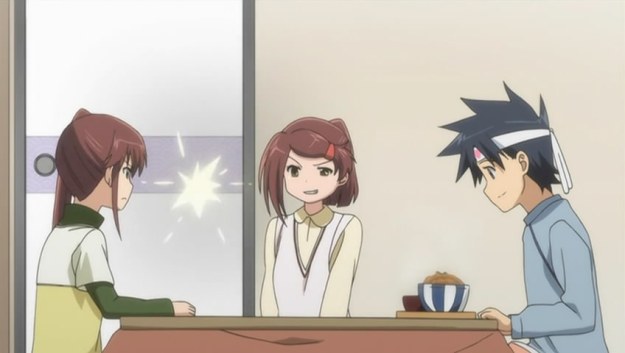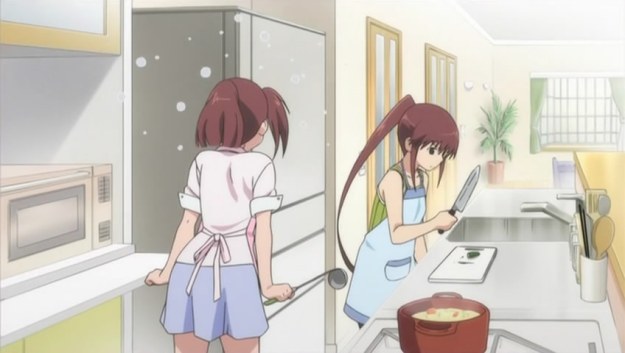In this post, I explore the similarities between Kiss x Sis and the mother-son incest myths that became all the rage the 1980s.
We learn in Sabine Fruhstuck’s Colonizing Sex: Sexology and Social Control in Modern Japan that since Japan’s modernization at the turn of the 20th century, education has long been considered the priority in nation-building (18). In promoting national health, theorists were to quick to focus in on children and their mothers. Children and their development represented Japan’s future, and as such, their education was of great concern to Japanese leaders. Mothers became important as well due to the role they play in guiding and shaping the education of their children (19). Although fathers played a necessary role in providing the financial base for the family, their influence upon the child was indirect and far eclipsed by the mother.
Following the postwar period, the change in government had not meant a change in priorities with regards to nation-building. Once again, the reconstruction of Japan relied upon “the traditional values of hard work and loyalty to the group and family” (Allison 143). The harsh academic examination system put in place forced women to sacrifice themselves for the success of their children. A child’s performance in school thus became synonymous with his or her mother’s value.
In the 1980s, sensationalist stories of mother-son incest began to appear in various publications, from low-brow to high-brow: “magazines for young women such as Josei Jishin, for adult women such as Fujin Koron, and for mixed adult audiences such as Gendai no Me” (123). These scandalizing tales were always remarkably similar:
…what is compelling about the Japanese mother-son incest stories… is their repetition of the same, fetishized scenario. All of the stories bracket the relationship between mother and male child as it enters the pivotal stage of exam preparation, which signals a boy’s maturation into adulthood, a mother’s test of her skills as a good mother, and the eventual separation between mother and child as the son moves on to school and a job. Sexual desire intrudes on this scene usually from the direction of the maturing boy and threatens the socially appropriate completion of the mother-son relation. Mother fears the sexualized boy will abandon his studies, fail to achieve success on his exams, and compromise his future. Her son’s failure would also mark her own failure as a mother. As the woman wards off this threat by offering to be her son’s sexual companion, she achieves sexual gratification for herself but also fulfills satisfactorally her job of maternal social reproduction and thereby papers over with fantasy a gap in her own life. Rarely do the stories of mother-son incest go beyond this point. The scenario thus stalls and repeats on just two interactions, sex between mother and son and cooperation on exam preparation. — page 126
Why did such “media myths” appear? Did they signify a disturbing trend among Japanese mothers and their sons during the 1980s? Many critics have disagreed, proclaiming that the amount of mother-son incest in Japan is no different from other first-world nations such as the US. Although she doesn’t think these stories were completely fabricated, Anne Allison suggests in Permitted and Prohibited Desires that these sensationalist stories represent a fear in Japanese society of overbearing mothers and their complete dominance in the development of the Japanese son. The details of her analysis, involving the ideas of Freud, Lacan and some feminist writers, are fascinating, but I won’t dive into that. If you’re curious of what she has to say, you can simply read her book yourself. I, however, am more interested in the odd similarities between Kiss x Sis and the mother-incest stories of the 1980s.
Kiss x Sis starts with Keita on the verge of entering high school. More importantly, he hopes to get into the same school that his two step-sisters are currently attending. Unfortunately, his present grades wouldn’t get him in:
Typically, it falls upon the mother of the Japanese family to make sure that the Japanese son is excelling in his schoolwork. In Kiss x Sis, however, the father is not the only absentee parent:
Although they do show up from time to time, Keita’s parents exert relatively little influence in his life. They serve more as comic relief than anything else. The responsibility of Keita’s development is thus left up to his two step-sisters, Ako and Riko. As a result, they both play the mother in the mother-son incest dynamic. One might object that Kiss x Sis contains no incest since Keita is not blood-related to either Ako or Riko, but this is merely a technicality that serves to whitewash the fetishizing nature of the anime. For all intents and purposes, Ako and Riko represents the symbolic mother.
How so? The plainly obvious evidence is that they’ve taken on the responsibility of making sure Keita succeeds in his studies:
Ako takes it upon herself to tutor Keita, where both the concerns for his grades and his developing sexuality overlaps.
Although she is more directly capable in improving Keita’s studies than Riko, she also imperils his efforts due to their sexual attraction. Like in the mother-son incest stories, success comes only when Ako manages to satisfy his urges in a way that allows him to concentrate on his schoolwork.
Riko, unable to directly assist Keita in his studies, struggles to measure up to Ako in other ways. In episode two, she stays after school to practice cooking, fulfilling another role typical of mothers.
In the ninth episode, they compete to see which girl can benefit him more as he crams overnight. Riko crafts a hachimaki to encourage a fighting spirit in Keita. On the other hand, Ako strikes back by cooking him a delicious midnight snack. The two sisters give each other death stares while Keita remains oblivious to the battle between the two siblings:
Their competition for Keita’s love seemingly revolves around motherly duties such as cooking, tutoring, and general encouragement. One could argue, however, that his sexual gratification mirrors that of the duty performed by the mothers in the mother-son incest stories. In those stories, the mother often worries that her son’s sexual development will distract him from his studies. As a result, she takes it upon herself to sexually gratify him so that he can go back to focusing on his studies. The competition between Ako and Riko for his love thus represents a competition between themselves as the better mother.
In the end, the anime ultimately asks which of the two sisters can properly raise Keita and ensure his stable entry into adulthood?
If we try to remove sexuality from the equation, Kiss x Sis is about becoming a proper Japanese adult. Keita’s constant need to study mirrors the salaryman who concerns himself with nothing but bringing home the buck and being the phallus symbol of the household. He does little, if anything, for his sisters other than striving for academic success and sexually gratifying them. Ako and Riko, on the other hand, are undergoing a development of their own: to become befitting mothers. Neither are perfect in satisfying Keita’s needs as the symbolic son; as a result, each girl makes up for what the other sister lacks (e.g. Ako cooks for Keita because Riko is notoriously bad at it). At the same time, however, they each attempt to rectify their own individual weaknesses, as demonstrated by Riko’s earnestness in improving her cooking. In Kiss x Sis, we thus see the seeds for the gendered division of work early in children’s development: Keita must strive to study hard because this represents his future in adult employment, while the girls must work hard to become supportive mothers and wives. Japanese men’s potential for philandering outside the home is even played out in episode five: Ako and Riko suspects Keita of “cheating” with a fellow classmate, Miharu, when he’s supposed to be studying at the school library, i.e. working.
In the 1990s, stories of mother-son incest disappeared from mainstream consciousness simply because, as Allison explains, sexually frustrated mothers were more likely to seek extramarital affairs than before. She, however, contends that “the dual specter of the overpowering mother and endangered male is crafted in other arenas such as the highly violent and misogynistic sexual imagery that proliferates in such popular media as television, animated films, and comic books” (145). Might Kiss x Sis serve as an example of what Allison is saying? Or by replacing the mother with two sisters, might the anime reflect the mother’s increasing absence from the home through the furthering of gender equality and/or extramarital relations? Or perhaps nothing has really changed since Ako and Riko assume the role of mother so closely anyway. Furthermore, there lies a huge difference between Kiss x Sis and the stories of mother-son incest: the incest of the latter is often considered evil, whereas Kiss x Sis revels in its deviant fantasies. What can we make of this? Perhaps attitudes toward sexual taboos have soften since the 1980s. With the recently perceived explosion in the number of NEETs and hikikomori, however, the overbearing matriarchy that the mother-son incest stories warned of may no longer represent a danger to young men. They may in fact prefer it to adult independence in a 21st century Japan beset with a declining marriage rate and a weak economy.








“One might object that Kiss x Sis contains no incest since Keita is not blood-related to either Ako or Riko, but this is merely a technicality that serves to whitewash the fetishizing nature of the anime.”
Nice logic.
So if I “shot” someone using a toy gun you’d call it a murder?
Don’t be dense. We all know the show’s trying to be edgy with incest while not being about incest at the same time.
I LOLed.
For anyone who wishes to continue arguing the incest point, consider this.
1. Cane sugar is sweet.
2. Corn syrup is sweet.
3. Cane sugar and corn syrup are the same.
This is a flawed argument and not the argument I am making. Rather, I’m saying:
1. Cane sugar is sweet.
2. Corn syrup is sweet.
3. If sweetness is the desired effect, cane sugar and corn syrup achieve the same desired effect.
Yes, the relationship in Kiss x Sis is not a by-the-book definition of incest because Keita is not blood-related to Ako and Riko. As his step-sisters, however, and for a myriad of other reasons, the same desired effect has been achieved as if the show had originally been about incest. Please consider this nuanced distinction before you continue to harp on the technicalities.
I sense some analytical writing practice for grad school here. ;)
This was good, though, especially for a show I don’t think I’ll get around to watching. Cheers.
Thanks for the kind words.
This was the post I wanted to make before I officially stopped following the anime.
The way you wrote this makes it sound like Kiss x Sis is actually watchable. So is it?
I don’t want to see another Kodomo no Jikan-like show in which every attempt at storytelling is drowned by the obnoxious Otaku-pandering and piles of fecal matter.
Nah. I think it’s a terrible show.
Then my judgement of making fun of this show was spot on.
i’m impressed, most people put their brain under the table when watching this kind of show, but you still keep it in your head, and made analysis of it. Bravo!
Sorry if my english suck, not my native language you see
where is translate for this storis
we all are humans and teenagers and their harmones in them are all part of human insticts
we all are humans and teenagers and their harmones in them are all part of human insticts andall
That was quite fascinating. I never knew about the rise of mother-son incest stories in the 80’s, so this entire read was interesting.
I somehow doubt the creators of this show are intending the underlying theme of becoming an adult. It’s far more likely they’re enjoying the ratings that come as a result of pandering to an incest-adoring audience, especially since the incest in this case is “pseudo-incest”, and would be legal. However, I love that you’ve taken the time to deconstruct this (quite stupid spunding) show to give it a deeper meaning.
Thank you for the interesting read. :)
Sure, but I never argued that the creators intended anything.
Thanks for reading.